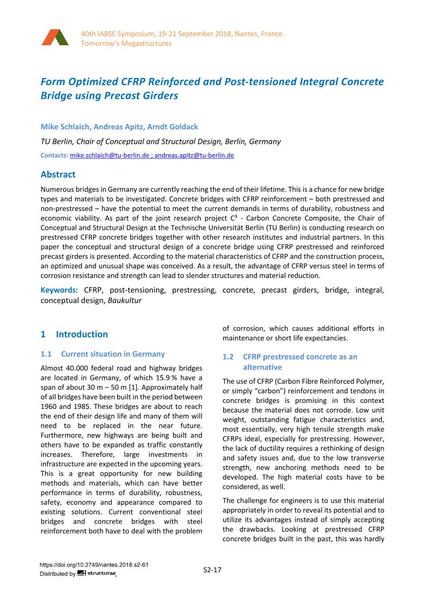Form Optimized CFRP Reinforced and Post-tensioned Integral Concrete Bridge using Precast Girders

|
|
|||||||||||
Bibliographic Details
| Author(s): |
Mike Schlaich
(TU Berlin, Chair of Conceptual and Structural Design, Berlin, Germany)
Andreas Apitz (TU Berlin, Chair of Conceptual and Structural Design, Berlin, Germany) Arndt Goldack |
||||
|---|---|---|---|---|---|
| Medium: | conference paper | ||||
| Language(s): | English | ||||
| Conference: | IABSE Symposium: Tomorrow’s Megastructures, Nantes, France, 19-21 September 2018 | ||||
| Published in: | IABSE Symposium Nantes 2018 | ||||
|
|||||
| Page(s): | S2-17 | ||||
| Total no. of pages: | 8 | ||||
| DOI: | 10.2749/nantes.2018.s2-61 | ||||
| Abstract: |
Numerous bridges in Germany are currently reaching the end of their lifetime. This is a chance for new bridge types and materials to be investigated. Concrete bridges with CFRP reinforcement – both prestressed and non-prestressed – have the potential to meet the current demands in terms of durability, robustness and economic viability. As part of the joint research project C³ - Carbon Concrete Composite, the Chair of Conceptual and Structural Design at the Technische Universität Berlin (TU Berlin) is conducting research on prestressed CFRP concrete bridges together with other research institutes and industrial partners. In this paper the conceptual and structural design of a concrete bridge using CFRP prestressed and reinforced precast girders is presented. According to the material characteristics of CFRP and the construction process, an optimized and unusual shape was conceived. As a result, the advantage of CFRP versus steel in terms of corrosion resistance and strength can lead to slender structures and material reduction. |
||||
| Keywords: |
concrete bridge conceptual design prestressing post-tensioning integral precast girders CFRP Baukultur
|
||||
